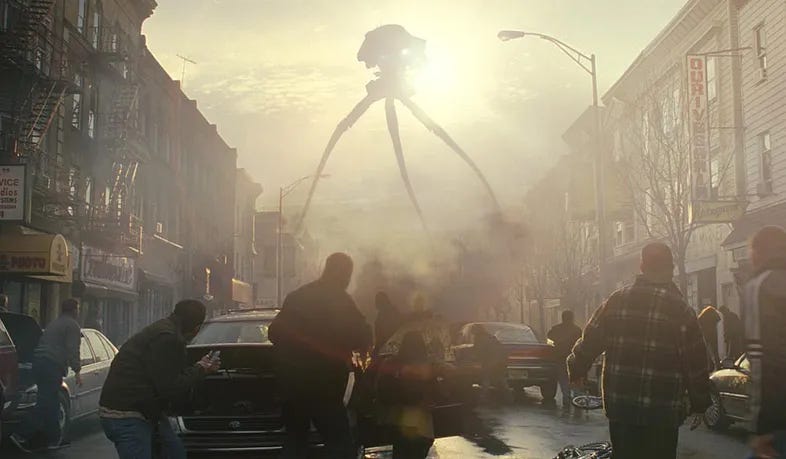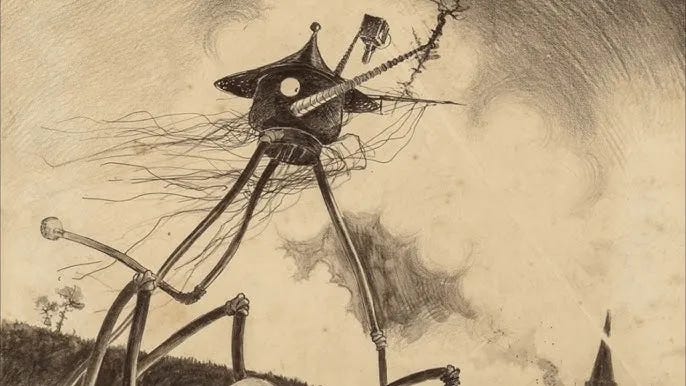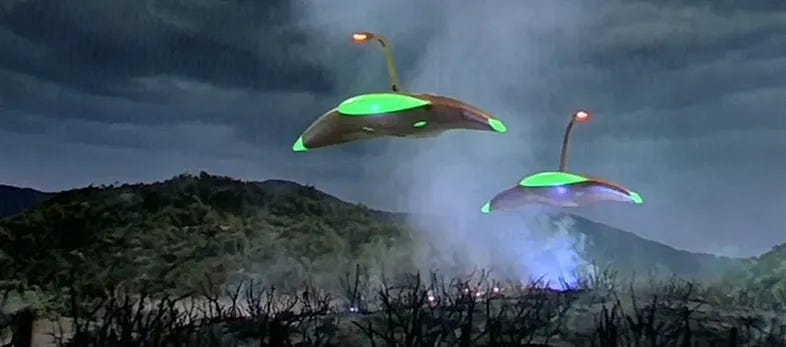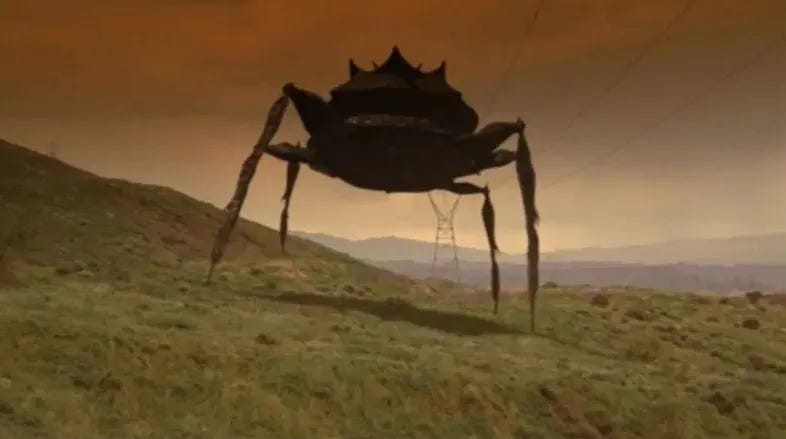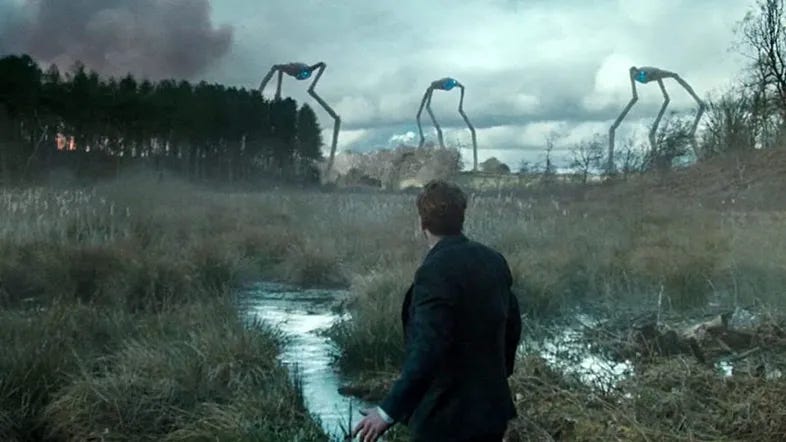H.G. Wells’ War of the Worlds, first serialized in 1897 in Pearson’s Magazine and later published as a novel, stands as a foundational work of science fiction. Its depiction of an attack on our planet by a murderous and technologically superior race from Mars — an entirely new concept at the time — has fascinated readers and filmmakers alike, setting the stage for a new subgenre of science fiction: the alien invasion.
The Invasion Begins
Despite War of the Worlds’ literary success, film and TV adaptations of the story have varied greatly in quality. It wasn’t until the 1950s, in the wake of UFO hysteria and post-war anxieties, that the invasion genre found its footing in American cinema. While some groundwork had already been laid by Orson Welles and his infamous The War of the Worlds radio broadcast in 1938, public fears, fueled by events like the 1947 Roswell incident and the rising paranoia of the Cold War, provided fertile ground for alien invasion narratives.
For those unfamiliar with the novel, here’s a quick overview: War of the Worlds is set in late 19th-century England, where Martians, fleeing their dying world, launch a devastating invasion. The story follows an unnamed journalist on his journey from Surrey toward London, through a landscape increasingly ravaged by the extraterrestrial attack, to find his wife and brother.
The blood-drinking invaders crush humanity’s military defenses but ultimately fall to Earth’s bacteria and viruses — organisms to which humans have developed immunity over countless generations.
H.G. Wells intended The War of the Worlds to be a lesson in humility — a strong reminder that humanity isn’t as powerful as it thinks. As we destroy and enslave other species, we might one day find ourselves on the receiving end of cruelty and conquest. It is a story meant for both excitement and reflection.
A Personal Fascination
I’ve always had a soft spot for Wells’ tale of angry Martians descending on Earth to wreak havoc. My fascination began when I was just a child, around 7 or 8. After my father introduced me to Star Wars, I craved more spaceships, aliens, and laser battles — I was hooked! One evening, he brought home a VHS of the 1953 film The War of the Worlds. I can still picture it: sitting between my parents, completely fascinated… until the moment a Martian periscope slowly emerged from the crater. Terrified, I ended up hiding behind the couch, clutching a pillow over my eyes.
That night sparked a lifelong interest in War of the Worlds. As a film and science fiction fan, I try to see every adaptation, whether it’s a film, TV series, radio play, musical, or something else entirely, no matter how bad they are. While many of these versions miss the novel’s core message, they’re often interesting — and sometimes hilariously off-base — interpretations. But once in a while, some of them find their mark, often in unexpected ways!
A Look at the Adaptations
While War of the Worlds may not rival Dracula in sheer number of adaptations, it still boasts around 30 versions across various media, including films, series, animated features, and even video games.
In this article, I’ve selected a range of these adaptations — from the very best to the truly awful — to showcase the wildly different takes on H.G. Wells’ iconic story. This overview focuses exclusively on live-action films and TV series, so I’ve excluded radio shows, audiobooks, video games, animated films like the steampunk-inspired War of the Worlds: Goliath, and musical versions, such as Jeff Wayne’s musical and stage show.
The War of the Worlds (1953)
Directed by Byron Haskin, the 1953 adaptation is widely regarded as a genre-defining classic. Starring Gene Barry and Ann Robinson (who later made cameos in Spielberg’s 2005 version), the film won an Oscar for its special effects — impressive for its time.
However, like many adaptations, it partially misinterprets Wells’ original message. While the novel highlights humanity’s vulnerability and the invaders’ downfall due to Earth’s bacteria, the film leans more heavily into the idea of divine intervention. Despite this shift, it’s a must-watch for its historical significance in sci-fi cinema.
War of the Worlds (1988–1990)
Ah, the ‘80s… when things got truly weird. This TV series picks up after the events of the 1953 film, revealing that the Martians weren’t entirely defeated; they’ve just been in hibernation.
Governments, for reasons that remain unclear, have inexplicably stored the aliens’ bodies in barrels of chemicals in poorly guarded facilities worldwide. During a shootout, one of these barrels is hit, accidentally reawakening the aliens. Conveniently, they now have the ability to merge with human hosts, Invasion of the Body Snatchers-style, making it easier to infiltrate governments (and save on the special effects budget!). What follows is a bizarre, at times incredibly brutal, and unintentionally hilarious series that, despite its many flaws, somehow managed to gain a cult following.
A second season was made, setting the story in a dystopian future. These days, it’s hard to track down, and I have yet to be… fortunate enough to find more than an episode or two.
H.G. Wells’ The War of the Worlds (2005)
Directed by Timothy Hines, this adaptation may be the most faithful to the novel in terms of setting and plot, but beyond that, it’s an unmitigated disaster. Clocking in at nearly three hours, this low-budget fiasco is littered with technical mishaps, abysmal special effects, and continuity errors that would make Ed Wood blush. The lead actor’s fake mustache practically deserves its own IMDb page, as it seems to have a mind of its own.
If you’ve got the stamina — and sanity — to spare, it’s worth a watch for the laughs or as a cautionary tale on what not to do as a filmmaker, even on a tight budget. Last I checked, it was hard to track down, but if it hasn’t surfaced on YouTube yet, it’s probably only a matter of time.
War of the Worlds (2005)
Oh God, it’s The Asylum, the studio behind Sharknado and the undisputed king of mass-producing tasteless trash and mockbusters. In 2005, hot on the heels of Steven Spielberg’s massive blockbuster adaptation of War of the Worlds, this less-than-vaunted production company regurgitated its own version of the story.
While it loosely follows the novel’s outline, it’s set in present-day America, complete with all the low-budget acting and cringe-worthy effects you’d expect. At least it has Jake Busey, chewing every piece of scenery as a mad army general. Still, approach this one with caution — and maybe a stiff drink.
War of the Worlds (2005)
Directed by Steven Spielberg and starring Tom Cruise, this is hands-down my favorite adaptation. With an incredible cast that includes Tom Cruise, Dakota Fanning, Tim Robbins, and Miranda Otto, this film captured the zeitgeist of its time, feeling both personal and epic. The story focuses on a divorced father desperately trying to protect his children during an all-out alien invasion.
Spielberg draws inspiration from real-world disasters, weaving in themes of war, terrorism, and survival that add a haunting, grounded depth alongside intense action and genuinely terrifying scenes of alien brutality. This mix of high stakes and emotional resonance makes it, for me, the strongest adaptation on this list.
Nearly 20 years since War of the Worlds first premiered, it still has a devoted fanbase. Even as of this writing, a passionate indie gaming studio is developing a survival horror game based on the film — and from early looks, it’s shaping up to be pure nightmare fuel!
War of the Worlds 2: The Next Wave (2008)
For some reason, The Asylum decided that their 2005 mockbuster needed a sequel. Set three years after the initial invasion, this time, humans travel to Mars in spaceships to take the fight to the aliens. It’s as bad as it sounds, with terrible acting, cringeworthy effects, and no direction to speak of. Watch only if you’re a film masochist — and only after enduring the first one.
I’m sure The Asylum has spawned more sequels and spinoffs, but my tolerance for their cinematic atrocities has its limits.
War of the Worlds: The True Story (2012)
This “mockumentary” combines clips from the 2005 film with new footage and interviews with fictional survivors, soldiers, and scientists, alongside actual World War I archival material. Directed by Timothy Hines, it’s surprisingly engaging and original, offering a fresh take on the story.
It’s certainly a departure from the original novel. Does it redeem Hines for his 2005 version of The War of the Worlds (see above)? Well, not exactly. But it’s still worth watching for its unique approach.
War of the Worlds (2019)
Marketed as a modern take on Wells’ story, this French-American series quickly veers away from its source material. Instead of a faithful adaptation, we get a post-apocalyptic survivor saga reminiscent of The Walking Dead, but with killer robotic dogs in place of tripods and teenagers with superpowers. Though visually appealing and often well-acted, the concept diverges so drastically that it’s connected to War of the Worlds in name only.
Still, with a cast including Gabriel Byrne and Daisy Edgar-Jones, the show, which features time-traveling humans rather than aliens, quickly built a fan following. Last I checked, it was in its third season.
War of the Worlds (2020)
Set in early 20th-century England, this BBC mini-series stays loosely faithful to Wells’ novel. With standout performances from Eleanor Tomlinson, Rafe Spall, and Robert Carlyle, it’s a polished and well-executed production. However, the series weaves in a prominent political message on gender equality that some viewers felt clashed with the original story’s context.
Unfortunately, the final episode veers sharply off course, ultimately dropping the ball on Wells’ intended message and core themes, as if the BBC was determined to reinvent the story simply for reinvention’s sake. Despite these issues, it is strongly recognizable, at least visually, as a War of the Worlds adaptation.
Final Thoughts
These are just a few of the many adaptations of War of the Worlds, and undoubtedly, more will follow as filmmakers continue to reinterpret Wells’ classic tale. Like the cosmic horror works of authors such as H.P. Lovecraft (see my article on film adaptations of Lovecraft’s work here), Wells’ work is now open for anyone to adapt.
But certain elements, in my view, should always remain intact: a massive alien invasion by towering, unstoppable war machines (bonus points for tripods); mysterious, deadly aliens bent on humanity’s extermination (bonus points if they drink blood); and, most importantly, a conclusion where the aliens are defeated not by human effort (and certainly not by faith or divine intervention) but by Earth’s own bacteria and their own hubris. Filmmakers who stray too far from these essentials might consider a different title.
Originally conceived as a critique of imperialism (a bold stance in 19th-century England) and a cautionary tale about exploiting nature, War of the Worlds still resonates today. By placing humanity in a position of vulnerability, Wells challenged social hierarchies and colonial assumptions, making the novel’s themes as relevant now as when it first shocked readers.




